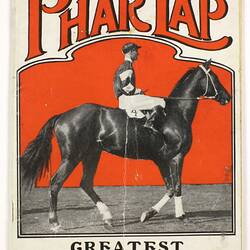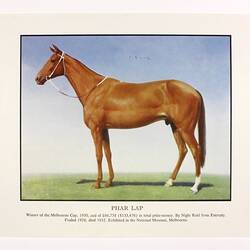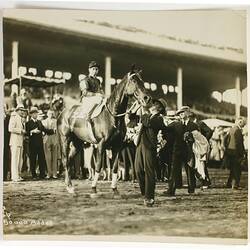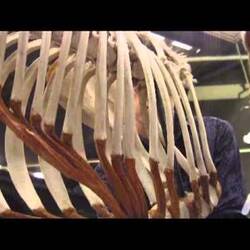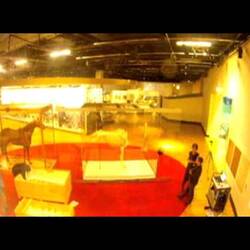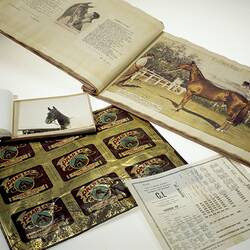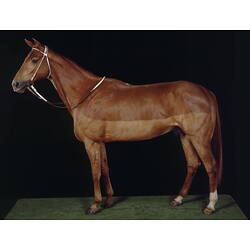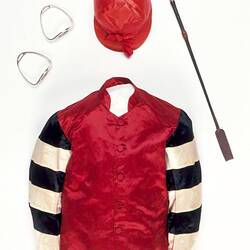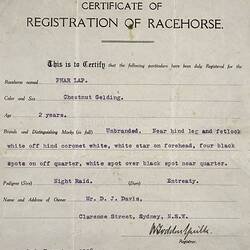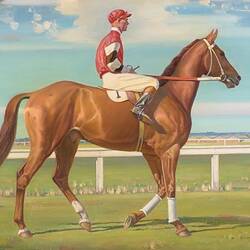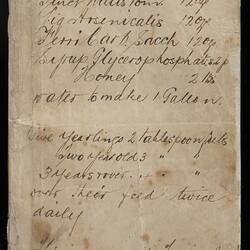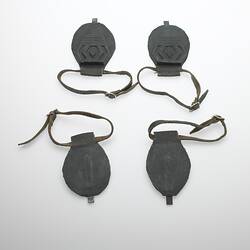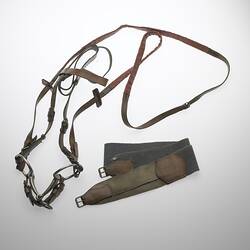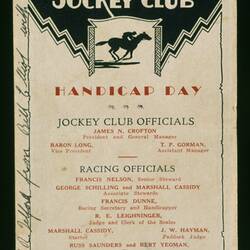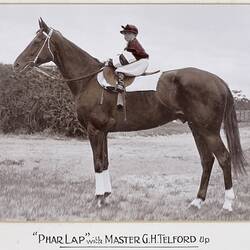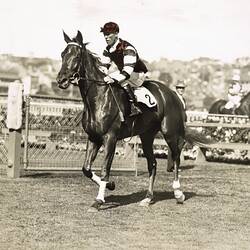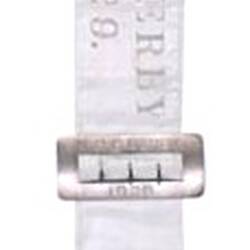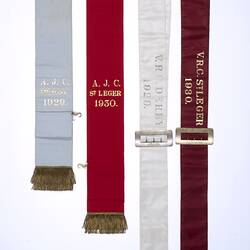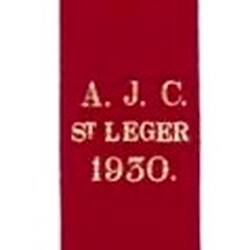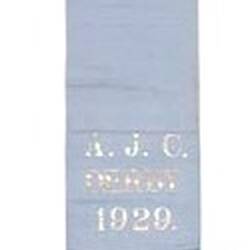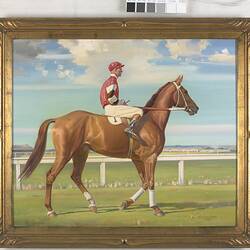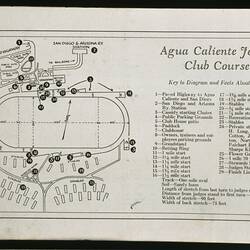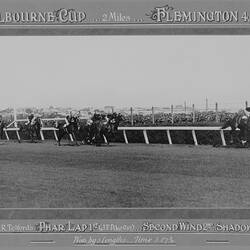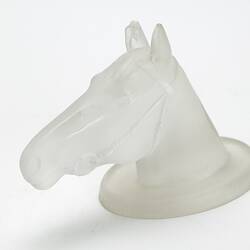Phar Lap is Australia's most famous racehorse. He attained legendary status before his tragic death and this fame has continued to grow ever since.
The Colt from Timaru
He was foaled at Seadown Stud, near Timaru, New Zealand, from a pairing of the English sire Night Raid and local mare Entreaty, being born on 4 October 1926. Despite a strong pedigree which included such notable names as Carbine, winner of the 1890 Melbourne Cup, the young chestnut colt offered little promise as a yearling. He was generally regarded as too big and ungainly, being unkindly referred to as a 'giraffe' or 'ugly duckling of the racecourse'.
It was the battling Sydney trainer, Harry Telford, who first saw potential in the colt listed simply as 'Lot 41' in the Catalogue of the Annual New Zealand Thoroughbred Yearling Sales to be auctioned on 24 January 1928. Without the funds to purchase the horse himself, he convinced the Sydney businessman and horse owner, David J. Davis to invest 160 guineas (£168) to buy the horse sight unseen. When Davis first inspected the horse on its arrival in Sydney, he was so unimpressed that he refused to outlay any further funds on its training or upkeep. Telford took the horse on under a three year lease paying all ongoing expenses out of his own pocket, in return for a two-thirds share of any winnings.
The colt from 'Lot 41' was registered as a racehorse by Davis under the name Phar Lap on 3 December 1928. Various stories abound about the origin and meaning of the name - the most common suggestion being that the words meant 'lightning' or 'wink of the skies' in the Siamese or Thai language. It appears that the name was first suggested by Aubrey Ping, a young medical student of southern Chinese descent at the University of Sydney, who regularly watched the horses in trackwork at Randwick and would often 'chew the fat' with riders and trainers.
Finding Winning Form
Phar Lap raced only five times as a two-year-old, for one small win. There was talk he would make a better jumper. After a spell and further hard training he slowly improved, then during the Spring of 1929 he recorded a series of dazzling wins, including the Victoria Derby and AJC Derby. As an even priced favourite he narrowly lost the 1929 Melbourne Cup, running third behind Nightmarch, another son of Night Raid - a loss put down to inexperience on the part of both horse and rider with his regular jockey Jimmy Pike being changed at short notice.
By March of 1930, Phar Lap had returned to winning form, and would finish first in all but one of his next 24 starts. Victory in the 1930 Melbourne Cup as the shortest priced favourite in the race's history, made him a household name. Racing was the first sport covered live by radio in Australia, from about 1927. Previously racing had a name for being the sport of the 'filthy rich and the untidy poor'. With radio, Phar Lap's success could be followed by anyone without the need to set foot on a racecourse. In lounge rooms, clubs and pubs throughout Australia, people felt close to 'the action'. Betting gave people a further sense of participation. Every pub and factory had an illegal 'SP bookie' - a bookmaker who paid at the 'starting price' odds offered by legal on-course bookmakers.
A National Hero
Although Phar Lap's odds were often very short, he won so often it is no wonder he became the people's friend. Depression hero Phar Lap came good just when the economy went bad. The October 1929 stock market collapse led to widespread unemployment and misery. While the Depression broke lives, Phar Lap broke records. Throughout Australia, people listened with anticipation every time Phar Lap raced. Each win heightened the national sense of awe. He'd done it again! Between September 1929 and March 1932, Phar Lap ran 41 races over a variety of distances from 7 furlongs (1,400 m) to 2 miles (3,200 m). He won an astonishing 36 of them. To racing officials he was just too good. They changed the weight-for-age scale in a bid to make it easier for other horses to win. It didn't work. The last two times Phar Lap failed to win: he was sick. On both occasions trainer Harry Telford had ignored the pleas of his strapper Tommy Woodcock not to run Phar Lap.
Having won almost every major Australian race, many of them twice, Phar Lap's owners turned their eyes to the world's richest race - North America's Agua Caliente Handicap. As the star of track and screen Phar Lap was an accessible hero. His achievements gained widespread media exposure. Audiences followed his major wins by radio and relived them on the new 'talkie' newsreels at their local cinemas. In daily newspapers he frequently moved out of the sports section and onto the front page as editors discovered he was good for sales. Phar Lap became a 'bankable' sports personality, just as the full potential of commercial links between sport, media and marketing were beginning to be understood and exploited. With such intense media focus, people felt they actually knew Phar Lap.
Tragedy in America
When he beat the best American horses to easily win the Agua Caliente Handicap by two lengths, Australia was euphoric. While newsreel footage of his win was still on the ship from America, Australians tuning into their radios around 10.30 am on Wednesday, 6th April 1932, heard the first shocking news that Phar Lap was dead! - having died suddenly in mysterious circumstances. Competing theories about the cause of his death spread like wildfire over subsequent days. An official autopsy by American veterinary experts concluded that the probable cause was either colic or a bacterial infection, but the evidence was far from conclusive. The only thing that was clear was that he had suffered severe stomach and intestinal inflammation and had traces of arsenic in his system. American racing experts blamed Phar Lap's Australian handlers, claiming they had allowed him to eat green feed, damp and soiled feed brought from Australia or foliage from a tree sprayed with insecticide. But Tommy Woodcock, Phar Lap's strapper and primary carer was convinced that the horse had been deliberately poisoned, having had first-hand experience of the violent and underhand ways of dubious characters in the American racing industry following his arrival in the country.
The sense of loss to the Australian public was overwhelming. Like all champion racehorses before and since, Phar Lap followed what is known as the thoroughbred industry 'money trail'- 10 racetracks, 3 Australian states, 4 countries, 51 starts. Throughout his hectic career, the one constant in Phar Lap's life was strapper Tommy Woodcock. As long as he was around, Phar Lap was happy. When Phar Lap suddenly took ill on 5 April 1932, Tommy Woodcock was there and the champion died in his arms.
Life After Death
When Phar Lap died there was a scramble among several institutions in Australia for his mortal remains. Phar Lap's huge heart went to the National Institute of Anatomy in Canberra; his skeleton went to the Dominion Museum in New Zealand; and his mounted hide - the most prized part - went to the National Museum of Victoria in Melbourne. Davis arranged to have Phar Lap taxidermied by Jonas Brothers of New York. Altogether the work took four and a half months. The hide was mounted on a hollow shell of moulded materials such as burlap, building paper and plaster, over a steel framework so strong it could support the weight of an adult. Phar Lap was installed in the National Museum of Victoria in Melbourne in January 1933. He stayed there for almost 70 years. In 2000 Phar Lap was removed from the old museum building and moved up the hill to the new Melbourne Museum.
In September 2010 to mark the 80th annivarsary of his 1930 Melbourne Cup win, Phar Lap's mounted hide was reunited with his skeleton on loan from the Te Papa Tongarewa Museum in Wellington, New Zealand, on a 4 ½ month loan.
Related Resources:
Phar Lap's Race Statistics
Videos of Phar Lap at the National Film and Sound Archive
References:
Armstrong, Geoff & Thompson, Peter, 2000, Phar Lap, Allen & Urwin, Melbourne.
Reason, Michael, 2005, Phar Lap: A True Legend, Museum Victoria, Melbourne (revised edition 2009).
Woodcock, Tommy, 'Phar Lap Memories', a series of articles published in 25 parts in The Mercury (Hobart), 19 Sep 1936 - 16 Dec 1936.
Phar Lap's skeleton at the Museum of New Zealand, Te Papa Tongarewa
More Information
-
Keywords
-
Authors
-
Article types


